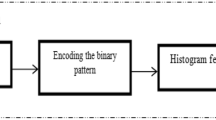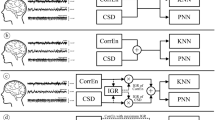Abstract
The Electroencephalogram (EEG) signal processing is one of the extensively used research field in recent days, in which the epileptic seizure detection and classification plays an essential role. It is very hard to determine the network of EEG signal, because it contains enormous and fluctuated information about the actions of the brain. Therefore, the earlier research works focused to detect the seizure based on its features. For this reason, it implemented various feature extraction, feature selection, and classification algorithms during the abnormality prediction. But, it has the major drawbacks of inefficient classification results, utilizing large amount of features, and increased complexity. To solve these problems, this paper aims to develop a Masking and Check-in based Feature Extraction Technique (MCFET) and an integrated K-Means with K-Nearest Neighbor classification algorithms for detecting whether the EEG signal is normal or abnormal. Initially, the features of the signal such as Signal to Noise Ratio, variance, and Standard Deviation are extracted by generating the mask value based on the check-in function. After that, the extracted features are given as the input for classification, where both the Euclidean distance and Chebyshev distance are computed. Based on the minimum similarity value, the signal is classified as normal, or abnormal (i.e. interictal or ictal). In experiments, the performance of the proposed MCFET with modified k-NN are evaluated by using different performance measures. Also, the superiority of the technique is proved by comparing it with some existing techniques.



Similar content being viewed by others
References
Acharya, U. R., et al. (2015). Application of entropies for automated diagnosis of epilepsy using EEG signals: a review. Knowledge-Based Systems, 88, 85–96.
Akareddy, S. M., & Kulkarni, P. (2013). EEG signal classification for epilepsy seizure detection using improved approximate entropy. International Journal of Public Health Science (IJPHS), 2, 23–32.
Al-Fahoum, A. S., & Al-Fraihat, A. A. (2014). Methods of EEG signal features extraction using linear analysis in frequency and time–frequency domains. ISRN Neuroscience, 2014, 267–276.
Alickovic, E., et al. (2018). Performance evaluation of empirical mode decomposition, discrete wavelet transform, and wavelet packed decomposition for automated epileptic seizure detection and prediction. Biomedical Signal Processing and Control, 39, 94–102.
Andrzejak, R. G., et al. (2001). Indications of non-linear deterministic and finite dimensional structures in time series of brain electrical activity: Dependence on recording region and brain state. Physical Review E, 64, 061907. https://doi.org/10.1103/PhysRevE.64.061907.
Bajaj, V., & Pachori, R. B. (2013). Epileptic seizure detection based on the instantaneous area of analytic intrinsic mode functions of EEG signals. Biomedical Engineering Letters, 3, 17–21.
Bizopoulos, P. A., et al. (2013). EEG epileptic seizure detection using k-means clustering and marginal spectrum based on ensemble empirical mode decomposition. In 2013 IEEE 13th international conference on bioinformatics and bioengineering (BIBE) pp. 1–4.
Bogaarts, J., et al. (2014). EEG feature pre-processing for neonatal epileptic seizure detection. Annals of Biomedical Engineering, 42, 2360–2368.
de Albuquerque, V. H. C., Nunes, T. M., Pereira, D. R., Luz, E. J. D. S., Menotti, D., Papa, J. P., et al. (2018). Robust automated cardiac arrhythmia detection in ECG beat signals. Neural Computing and Applications, 29, 679–693.
Elgohary, S., et al. (2016). Epileptic seizure prediction using zero-crossings analysis of EEG wavelet detail coefficients. In 2016 IEEE conference on computational intelligence in bioinformatics and computational biology (CIBCB), pp. 1–6.
Faust, O., et al. (2015). Wavelet-based EEG processing for computer-aided seizure detection and epilepsy diagnosis. Seizure, 26, 56–64.
Fu, K., et al. (2015). Hilbert marginal spectrum analysis for automatic seizure detection in EEG signals. Biomedical Signal Processing and Control, 18, 179–185.
Fujiwara, K., et al. (2016). Epileptic seizure prediction based on multivariate statistical process control of heart rate variability features. IEEE Transactions on Biomedical Engineering, 63, 1321–1332.
Hoyos-Osorio, K., et al. (2016). Automatic epileptic seizure prediction based on scalp EEG and ECG signals. In 2016 XXI Symposium on signal processing, images and artificial vision (STSIVA), pp. 1–7.
Kumar, T. S., et al. (2014). Classification of seizure and seizure-free EEG signals using multi-level local patterns. In 2014 19th international conference on digital signal processing (DSP), pp. 646–650.
Kumar, Y., et al. (2014a). Epileptic seizures detection in EEG using DWT-based ApEn and artificial neural network. Signal, Image and Video Processing, 8, 1323–1334.
Kumar, Y., et al. (2014b). Epileptic seizure detection using DWT based fuzzy approximate entropy and support vector machine. Neurocomputing, 133, 271–279.
Lee, S.-H., et al. (2014). Classification of normal and epileptic seizure EEG signals using wavelet transform, phase-space reconstruction, and Euclidean distance. Computer Methods and Programs in Biomedicine, 116, 10–25.
Liu, R., et al. (2016) Normalized gabor entropy analysis of iEEG for prediction of epileptic seizures. In 2016 32nd southern biomedical engineering conference (SBEC), pp. 15–16.
Ma, Z., & Tavares, J. M. R. (2017). Effective features to classify skin lesions in dermoscopic images. Expert Systems with Applications, 84, 92–101.
Nunes, T. M., et al. (2014). EEG signal classification for epilepsy diagnosis via optimum path forest—a systematic assessment. Neurocomputing, 136, 103–123.
Oh, S.-H., et al. (2014). A novel EEG feature extraction method using Hjorth parameter. International Journal of Electronics and Electrical Engineering, 2, 106–110.
Oliveira, R. B., Papa, J. P., Pereira, A. S., & Tavares, J. M. R. (2016). Computational methods for pigmented skin lesion classification in images: review and future trends. Neural Computing and Applications, 27, 1–24.
Oliveira, R. B., Pereira, A. S., Tavares, J. M. R. (2018). Computational diagnosis of skin lesions from dermoscopic images using combined features. Neural Computing and Applications 1–21.
Omerhodzic, I., et al. (2013). Energy distribution of EEG signals: EEG signal wavelet-neural network classifier. arXiv preprint arXiv:1307.7897.
Pachori, R. B., & Patidar, S. (2014). Epileptic seizure classification in EEG signals using second-order difference plot of intrinsic mode functions. Computer Methods and Programs in Biomedicine, 113, 494–502.
Panichev, O., et al. (2015). Patient-specific epileptic seizure prediction using correlation features. In Signal processing symposium (SPSympo), 2015, pp. 1–5.
Riaz, F., et al. (2016). EMD-based temporal and spectral features for the classification of EEG signals using supervised learning. IEEE Transactions on Neural Systems and Rehabilitation Engineering, 24, 28–35.
Sałabun, W. (2014). Processing and spectral analysis of the raw EEG signal from the MindWave. Przeglad Elektrotechniczny, 90, 169–174.
Samiee, K., et al. (2015). Epileptic seizure classification of EEG time-series using rational discrete short-time Fourier transform. IEEE Transactions on Biomedical Engineering, 62, 541–552.
Satapathy, S. K., et al. (2017). EEG signal classification using PSO trained RBF neural network for epilepsy identification. Informatics in Medicine Unlocked, 6, 1–11.
Sharmila, A., & Geethanjali, P. (2016). DWT based detection of epileptic seizure from EEG signals using naive Bayes and k- NN classifiers. IEEE Access, 4, 7716–7727.
Spezialetti, M., Cinque, L., Tavares, J. M. R., Placidi, G. (2018). Towards EEG-based BCI driven by emotions for addressing BCI-Illiteracy: a meta-analytic review. Behaviour & Information Technology 1–17.
Author information
Authors and Affiliations
Corresponding author
Rights and permissions
About this article
Cite this article
Choubey, H., Pandey, A. A new feature extraction and classification mechanisms For EEG signal processing. Multidim Syst Sign Process 30, 1793–1809 (2019). https://doi.org/10.1007/s11045-018-0628-7
Received:
Revised:
Accepted:
Published:
Issue Date:
DOI: https://doi.org/10.1007/s11045-018-0628-7




